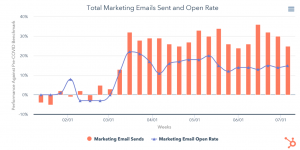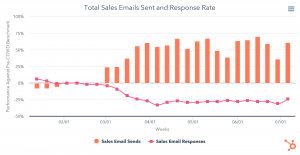6 COVID-19 B2B Tech Marketing Insights from 6 Days of Webinars
6 COVID-19 B2B Tech Marketing Insights from 6 Days of Webinars
Instead of using some recent extra time breadmaking, gardening or acquiring other hip COVID-19 skills to bedazzle my Facebook and IG friends, I filled a recent week joining some of the webinar invites flooding inboxes everywhere. Most took up a lot of my time and produced nothing memorable (like my sourdough attempts), but a few had good insights for enterprise tech marketers. This blog distills the insights from all those post COVID-19 outbreak webinars around two themes:
1. What’s happening with the audience most of us are trying to reach: Enterprise CIOs and their teams of software, security, cloud and network decision makers and influencers.
2. Changes and implications for enterprise technology marketers based on #1.
New mantra for enterprise CIOs: respond, recover, renew
CIO’s and their teams had a huge knee jerk reaction circa March 13 as COVID-19 swept across America. CIOs pivoted everything their teams were doing to respond and make sure their organization could still securely function as workers shifted to 100% remote, offices closed, supply chains stopped, etc. Technology solutions were piecemeal and band-aided together as short-term fixes to keep their workforce working with offices closed. If you were selling to IT and your business card didn’t say “Zoom” or another vendor that supports remote work, you’d just get in the way so most marketers made the wise choice to stay on the sideline.
Aggregated customer data from HubSpot, a marketing and sales CRM/automation platform, shows what we all knew- a massive drop in deals created and closed as the outbreak hit in mid-March.

Now four months later, the deal pipeline is improving and IT teams (our audience as B2B marketers) are working to recover which means: 1) fixing the band aid approach that was quickly put in place; 2) accelerate their evolution to a modern cloud architecture; and 3) cost management though not necessarily cost cutting. CIO and CISO organizations will be taking a closer look at everything to keep their virtual workforce productive such as dependence on specific individuals in case they become sick, cloud scaling capabilities, supply chain reliance, and of course security. A few Zoom Booms is nothing compared to a ransomware incident when key members of the response team are working remotely.
At the CEO and Board of Directors (BoD) level, dialing back previously planned/approved large capital expenditures affords IT leaders the opportunity to renew longer term strategic initiatives and reimagine solutions by using the previously allocated capex funds and the greater exposure to the BoD that CIOs will have. The renew phase will start to land in 2H 2020 and continue to first half 2021 and this is where the first two of my six insights are.
1. Digital transformation: The pandemic is placing digital transformation now as the #1 BoD priority which means CIOs have never had as much strategic impact on their firms as they will over the next 12 months. It also means that digital transformation projects that may not have had made the budget cut before COVID-19 now move above the line as other projects, like that new office building, are pushed off the list. The partnership between marketing leaders and IT leaders has never been more important.
2. Distributed work: The traditional office will look different with three of four enterprises reducing real estate by at least 5% as there will be fewer workers in offices, and each employee will require more space to be socially distanced properly. Employers will no longer limit sourcing jobs to a specific geographic market, especially if that market has its own separate pay scale like the Bay Area and New York. Marketers should plan on virtual for the next 12+ months in my opinion.
COVID-19 marketing & sales implications
For context I’m going to start with data from HubSpot again. Their data from more than 70K customers shows what our inboxes all knew, the volume of sales and marketing email sent at the start of the pandemic was way up and is staying that way. While open rates for marketing emails were up 10%-20% and staying above historical levels…

Response rates for sales emails are down about 25% which is a disturbing trend for marketers who partner closely with sales.

Click here for the latest across a few other metrics like website traffic, sales calls, and contact growth. HubSpot’s webinar on their data one was one of my favorite webinars!
What else does this mean for enterprise tech marketers?
1. Now is the time to train up your customer/prospect on your products and how it can help customers, and prospects. IT leaders are looking to make their teams more impactful and the more trained up your customers and prospects are the better they can take advantage of your products as enterprises move from recovery to renewal.
2. Adjust use cases and adjusted marketing copy for more empathy. Even if it doesn’t result in a new sale now, helping a customer better utilize what they have such as a new use case is a big win right now. For example if you provide application security, how about offering them a security health check for their new remote workforce? And marketing terms like “killer app” or “viral content” don’t mean what they used to.
3. Shift resources from in-person events through at least first half 2021. Even if your team is willing to attend an in-person event in Q1 2021, it doesn’t mean your customer or prospect feels the same. Marketers need to respect their customer’s concern to keep a healthy work force which likely means a continued absence of in-person events through at least the first half of 2021. Fewer in-person events frees up a lot of marketing budget, perhaps you should discuss with your IT leader how to redirect some marketing opex to improve your marketing tech stack?
4. Accommodate your audience being at home. Your audience is juggling their job, their roommates or family, network bandwidth, health, isolation etc. As a guy who just spent a week on way too many webinars, stop the hour-long webinar insanity! I’m convinced marketers can attract more attendees and give them a better experience by changing their webinars to 1) Make them short, 15 – 20 minutes max, 2) Get to the point quickly, nobody needs housekeeping items at the start of a webinar anymore, 3) Try different times and day so audiences can balance their home schedule or a staggered in-office work schedule down the road. Data from webinar firm On24 shows the effectiveness of early morning webinars up 25% and later in the day webinars up 20% after the outbreak. Also, Mondays and Fridays, are both way up for webinar effectiveness with increases of 128% and 30%, respectively.
I’ll wrap with one of the most memorable nuggets from all those webinars I joined courtesy of a Forrester analyst.
- Question: Why don’t they have COVID-19 in Antarctica?
- Answer: Because it’s ICE-solated.

For more information, contact Aventi Group here.





